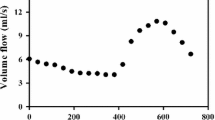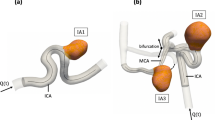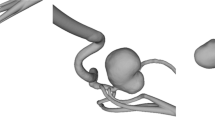Abstract
Introduction
Hemodynamics is thought to play a very important role in the initiation, growth, and rupture of intracranial aneurysms. The purpose of our study was to perform in vivo hemodynamic analysis of unruptured intracranial aneurysms of magnetic resonance fluid dynamics using time-resolved three-dimensional phase-contrast MRI (4D-Flow) at 1.5 T and to analyze relationships between hemodynamics and wall shear stress (WSS) and oscillatory shear index (OSI).
Methods
This study included nine subjects with 14 unruptured aneurysms. 4D-Flow was performed by a 1.5-T magnetic resonance scanner with a head coil. We calculated in vivo streamlines, WSS, and OSI of intracranial aneurysms based on 4D-Flow with our software. We evaluated the number of spiral flows in the aneurysms and compared the differences in WSS or OSI between the vessel and aneurysm and between whole aneurysm and the apex of the spiral flow.
Results
3D streamlines, WSS, and OSI distribution maps in arbitrary direction during the cardiac phase were obtained for all intracranial aneurysms. Twelve aneurysms had one spiral flow each, and two aneurysms had two spiral flows each. The WSS was lower and the OSI was higher in the aneurysm compared to the vessel. The apex of the spiral flow had a lower WSS and higher OSI relative to the whole aneurysm.
Conclusion
Each intracranial aneurysm in this study had at least one spiral flow. The WSS was lower and OSI was higher at the apex of the spiral flow than the whole aneurysmal wall.




Similar content being viewed by others
References
Imbesi SG, Kerber CW (1999) Analysis of slipstream flow in two ruptured intracranial cerebral aneurysms. AJNR Am J Neuroradiol 20:1703–1705
Mantha A, Karmonik C, Benndorf G et al (2006) Hemodynamics in a cerebral artery before and after the formation of an aneurysm. AJNR Am J Neuroradiol 27:1113–1118
Shojima M, Oshima M, Takagi K et al (2004) Magnitude and role of wall shear stress on cerebral aneurysm: computational fluid dynamic study of 20 middle cerebral artery aneurysms. Stroke 35:2500–2505
Meng H, Wang Z, Hoi Y et al (2007) Complex hemodynamics at the apex of an arterial bifurcation induces vascular remodeling resembling cerebral aneurysm initiation. Stroke 38:1924–1931
Tateshima S, Murayama Y, Villablanca JP et al (2003) In vitro measurement of fluid-induced wall shear stress in unruptured cerebral aneurysms harboring blebs. Stroke 34:187–192
Hassan T, Timofeev EV, Saito T et al (2004) Computational replicas: anatomic reconstructions of cerebral vessels as volume numerical grids at three-dimensional angiography. AJNR Am J Neuroradiol 25:1356–1365
Ujiie H, Tachibana H, Hiramatsu O et al (1999) Effects of size and shape (aspect ratio) on the hemodynamics of saccular aneurysms: a possible index for surgical treatment of intracranial aneurysms. Neurosurgery 45:119–129
Jou LD, Wong G, Dispensa B et al (2005) Correlation between lumenal geometry changes and hemodynamics in fusiform intracranial aneurysms. AJNR Am J Neuroradiol 26:2357–2363
Jou LD, Lee DH, Morsi H et al (2008) Wall shear stress on ruptured and unruptured intracranial aneurysms at the internal carotid artery. AJNR Am J Neuroradiol 29:1761–1767
Boussel L, Rayz V, McCulloch C et al (2008) Aneurysm growth occurs at region of low wall shear stress: patient-specific correlation of hemodynamics and growth in a longitudinal study. Stroke 39:2997–3002
Valencia A, Morales H, Rivera R et al (2008) Blood flow dynamics in patient-specific cerebral aneurysm models: the relationship between wall shear stress and aneurysm area index. Med Eng Phys 30:329–340
Cebral JR, Castro MA, Burgess JE, Pergolizzi RS, Sheridan MJ, Putman CM (2005) Characterization of cerebral aneurysms for assessing risk of rupture by using patient-specific computational hemodynamics models. AJNR Am J Neuroradiol 26:2550–2559
Szikora I, Paal G, Ugron A et al (2008) Impact of aneurysmal geometry on intra aneurysmal flow: a computerized flow simulation study. Neuroradiology 50:411–421
Ohshima T, Miyachi S, Hattori K et al (2008) Risk of aneurysmal rupture: the importance of neck orifice positioning-assessment using computational flow simulation. Neurosurgery 62:767–773
Markl M, Chan FP, Alley MT et al (2003) Time-resolved three-dimensional phase-contrast MRI. J Magn Reson Imaging 17:499–506
Isoda H, Hirano M, Takeda H et al (2006) Visualization of hemodynamics in a silicon aneurysm model using time-resolved, 3D, phase-contrast MRI. AJNR Am J Neuroradiol 27:1119–1122
Yamashita S, Isoda H, Hirano M et al (2007) Visualization of hemodynamics in intracranial arteries using time-resolved three-dimensional phase-contrast MRI. J Magn Reson Imaging 25:473–478
Bammer R, Hope TA, Aksoy M et al (2007) Time-resolved 3D quantitative flow MRI of the major intracranial vessels: initial experience and comparative evaluation at 1.5 T and 3.0 T in combination with parallel imaging. Magn Reson Med 57:127–140
Wetzel S, Meckel S, Frydrychowicz A et al (2007) In vivo assessment and visualization of intracranial arterial hemodynamics with flow-sensitized 4D MR imaging at 3 T. AJNR Am J Neuroradiol 28:433–438
Isoda H, Ohkura Y, Kosugi T et al. Comparison of hemodynamics of intracranial aneurysms between MR fluid dynamics using 3D cine phase-contrast MRI and MR based computational fluid dynamics. Neuroradiology (in press)
Shimai H, Yokota H, Nakamura S, et al (2005) Extraction from biological volume data of a region of interest with non-uniform intensity. In: Sumi K (ed) Optomechatronic machine vision. Proceedings of SPIE, vol. 6051, 605115
Lorensen WE, Cline HE (1987) Marching cubes: a high resolution 3D surface construction algorithm. Comput Graph 21:163–169
Press W, Teukolsky S, Vetterling W et al (1992) Numerical recipes in C. Cambridge University Press, Cambridge
Malek AM, Alper SL, Izumo S (1999) Hemodynamic shear stress and its role in atherosclerosis. JAMA 282:2035–2042
Masaryk AM, Frayne R, Unal O et al (1999) In vitro and in vivo comparison of three MR measurement methods for calculating vascular shear stress in the internal carotid artery. AJNR Am J Neuroradiol 20:237–245
Cheng CP, Parker D, Taylor CA (2002) Quantification of wall shear stress in large blood vessels using Lagrangian interpolation functions with cine phase-contrast magnetic resonance imaging. Ann Biomed Eng 30:1020–1032
Ku DN, Giddens DP, Zarins CK et al (1985) Pulsatile flow and atherosclerosis in the human carotid bifurcation. Positive correlation between plaque location and low oscillating shear stress. Arteriosclerosis 5:293–302
He X, Ku DN (1996) Pulsatile flow in the human left coronary artery bifurcation: average conditions. J Biomech Eng 118:74–82
Sho E, Sho M, Singh TM et al (2001) Blood flow decrease induces apoptosis of endothelial cells in previously dilated arteries resulting from chronic high blood flow. Arterioscler Thromb Vasc Biol 21:1139–1145
Baltes C, Kozerke S, Hansen MS et al (2005) Accelerating cine phase-contrast flow measurements using k-t BLAST and k-t SENSE. Magn Reson Med 54:1430–1438
Moftakhar R, Aagaard-Kienitz B, Johnson K (2007) Noninvasive measurement of intra-aneurysmal pressure and flow pattern using phase contrast with vastly undersampled isotropic projection imaging. AJNR Am J Neuroradiol 28:1710–1714
Acknowledgments
This study was supported by the grant from the Information-Technology Promotion Agency, Japan.
Conflict of interest statement
Dr. H. Isoda receives research funds from the Renaissance of Technology Corporation.
Author information
Authors and Affiliations
Corresponding author
Electronic supplementary materials
Below is the link to the electronic supplementary material.
Animation 1
3D streamlines of a right BA-SCA aneurysm. 3D streamlines of a BA-SCA aneurysm demonstrate that the aneurysm has spiral flow with its apex at its right caudal aspect of the aneurysm and has the low flow velocities at the apex. (M1V 1871 kb)
Rights and permissions
About this article
Cite this article
Isoda, H., Ohkura, Y., Kosugi, T. et al. In vivo hemodynamic analysis of intracranial aneurysms obtained by magnetic resonance fluid dynamics (MRFD) based on time-resolved three-dimensional phase-contrast MRI. Neuroradiology 52, 921–928 (2010). https://doi.org/10.1007/s00234-009-0635-3
Received:
Accepted:
Published:
Issue Date:
DOI: https://doi.org/10.1007/s00234-009-0635-3




